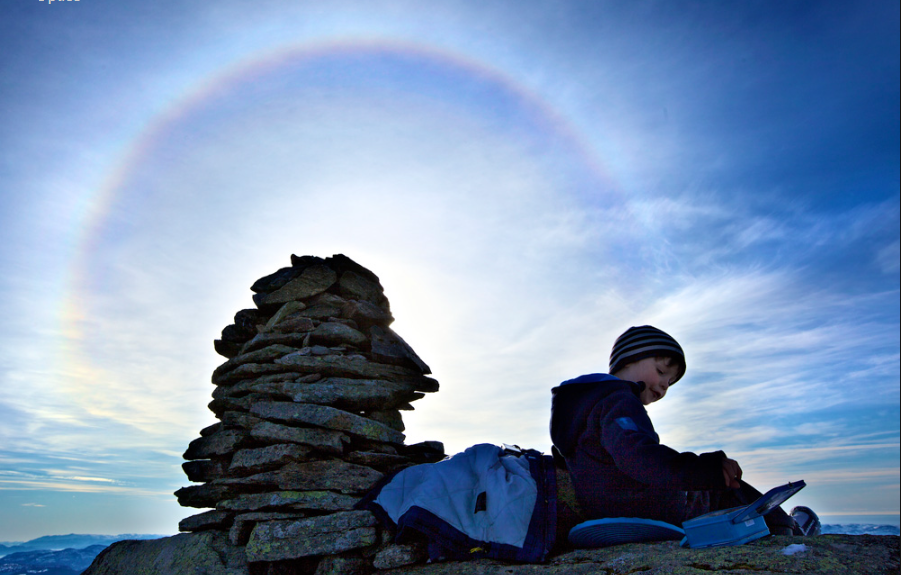Norway Boy & 22° Halo
The Norway Boy and the 22° Halo: A Captivating Atmospheric Phenomenon
Have you ever witnessed a breathtaking display of light in the sky that left you in awe? The Norway Boy and the 22° Halo is one such enchanting atmospheric phenomenon that has fascinated people around the world. In this article, we will delve into the details of this captivating event, exploring its causes, characteristics, and the mesmerizing visual spectacle it presents.
What is the 22° Halo?
The 22° Halo is a circular halo that forms around the Sun or Moon when light passes through ice crystals in the atmosphere. It appears as a ring with a radius of approximately 22 degrees around the celestial body. This optical phenomenon occurs due to the refraction and reflection of light within the hexagonal ice crystals suspended in the air.
The Norway Boy and his Halo Encounter
In Norway, a young boy named Pål Bentdal had a remarkable encounter with the 22° Halo. He was fortunate enough to capture this awe-inspiring phenomenon in a photograph that has since gained widespread attention. Pål's image beautifully showcases the halo encircling the Sun, illuminating the sky with its ethereal glow.
The Science Behind the 22° Halo
To understand how the 22° Halo forms, we need to explore the intricate interplay of light and ice crystals in the atmosphere. When sunlight or moonlight enters these hexagonal ice crystals, it undergoes refraction, bending at different angles as it passes through each crystal face. This bending causes the light to separate into its constituent colors, resulting in a display of vibrant hues within the halo.
Ice Crystal Orientation and Halo Shape
The orientation of the ice crystals plays a crucial role in determining the shape of the halo. The hexagonal crystals typically align themselves with their flat faces parallel to the ground. As a result, light enters one face, refracts, reflects off the inner faces, and exits through another face. This process repeats within the crystal, creating a multitude of light paths that ultimately converge to form the circular halo.
The 22° Halo and Other Atmospheric Optics
The 22° Halo is just one of many atmospheric optical phenomena that can occur under specific conditions. These include other halos, such as the 46° halo, the rare Parry arc, and the stunning circumzenithal arc. Each of these phenomena arises from different interactions between light and ice crystals, resulting in unique visual displays that continue to captivate both scientists and enthusiasts alike.
Capturing the Beauty: Photography Tips
If you ever find yourself in the presence of a 22° Halo or any other atmospheric optics spectacle, you may want to try capturing its beauty through photography. Here are a few tips to help you achieve stunning results:
- Use a wide-angle lens to capture the entire halo in your frame.
- Experiment with different exposure settings to enhance the colors and details.
- Include interesting foreground elements to add depth and context to your composition.
- Consider using a tripod for stability and longer exposures.
- Don't forget to take multiple shots from various angles to capture different perspectives.
Appreciating the Wonders of Nature
The Norway Boy and the 22° Halo serve as a reminder of the awe-inspiring wonders that nature presents to us. By understanding the science behind these phenomena and immersing ourselves in their beauty, we can cultivate a deeper appreciation for the world around us. So, next time you catch a glimpse of a halo encircling the Sun or Moon, take a moment to pause, marvel, and embrace the enchantment of the natural world.

Boy & 22 degre Halo, Norway - Image by Pål Bentdal (Frilans - Pål Bentdal).
©Pål Bentdal, shown with permission.
Note: this article has been automatically converted from the old site and may not appear as intended. You can find the original article here.
Reference Atmospheric Optics
If you use any of the definitions, information, or data presented on Atmospheric Optics, please copy the link or reference below to properly credit us as the reference source. Thank you!
-
<a href="https://atoptics.co.uk/blog/norway-boy-22-halo/">Norway Boy & 22° Halo</a>
-
"Norway Boy & 22° Halo". Atmospheric Optics. Accessed on April 19, 2024. https://atoptics.co.uk/blog/norway-boy-22-halo/.
-
"Norway Boy & 22° Halo". Atmospheric Optics, https://atoptics.co.uk/blog/norway-boy-22-halo/. Accessed 19 April, 2024
-
Norway Boy & 22° Halo. Atmospheric Optics. Retrieved from https://atoptics.co.uk/blog/norway-boy-22-halo/.